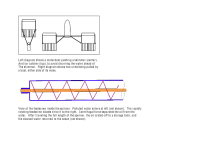I have big plans for my proposed oil film skimmers and tar/oil-ball collectors. They can be both hauled and powered by small motorboats. They are ideal low-cost, first-responders, designed for quick localized and third-world production. When oil threatens, your average Joes’ can ride out in small craft, like the little boats of Dunkirk, and save the beaches, without waiting for bean-counting glue-heads to sanction the effort. If they encounter fresh spills,or oilfilms dangerously thickened by wind or shore encroachment, the effort can pay for itself. For example, if the oilfilm thickness averages 0.01mm, and a boat skims a 10m wide path at 10mph (4.47 m/s), for eight hours, the potential harvest is a handy 12.9m3 or 111 US barrels!
The skimmers sip the first 20mm of the ocean’s surface via the red intakes at the front. These move independently on flexible supports, so as to ride-out wave movements. The airfoil-shaped strips beneath them are linear versions of a bulbous bow. They generate wave troughs that neutralize—trough to crest—any bow waves produced by the intakes.
Look—no pump! The skimmers and tar-removers are entirely powered by the boat, the speed of which generates sufficient dynamic pressure to drive the skimmed water-oil mix into the spinner mounted on the center section. The spinner may not look impressive, but it contains a screw-feeder (see inset), with about 20 turns. The paddlewheel (powered entirely by the rush of water sweeping through it), develops big-time torque, and drives the spinner via high-ratio gearing, generating large centrifugal forces. This causes the water (heavier than oil) to be flung to the rim of the spinner, while the lighter oil is forced to the center. The oil is drained off through a hollowed section of the shaft and routed to a storage tank. The now clean water is splashed back into the ocean.
The optional paddlewheel-driven device that rides ahead of the skimmer (see insets), captures heavy oil deposits in a rotating mesh. As shown in the drawing, the goop is scraped into a collector below the surface, from which it can be channeled to a storage tank. Surface oilfilms that accompanied the goop pass through the mesh largely undisturbed, ensuring that the water is restored to a settled condition before reaching the skimmer intakes. Note that the paddles do not churn the water, because, unlike Mississippi steamers, they are driven by the water, and thus follow the path of least resistance.
Like this entry?
-
About the Entrant
- Name:Neville Macaulife
- Type of entry:individual
- Hardware used for this entry:Very hardware in machine shop[Software used for this entry:Mathcad, MS Word, Autocad, Sketchup
- Patent status:pending








